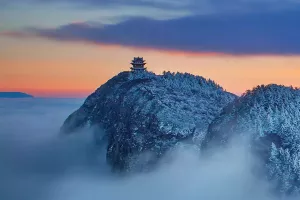The Canadian Rocky Mountains have been named one of the "50 places you must visit in your lifetime" by National Geographic. The variety of geology here is rich, and the vertical diversity of landscape makes you dazzled. There are lakes, snow-capped mountains, meadows, fields, rivers, forests, glaciers, hot springs, waterfalls, canyons, and ice fields, showing different beautiful scenery throughout the year.
The Rocky Mountains were formed between 80 million and 55 million years ago, when crustal movement and glacial erosion created peaks and valleys with prominent ravines. The rivers flowing from here run to three oceans, connecting Banff, Jasper, Kootenay, and Humber Provincial Park to form a beautiful alpine landscape, known as the Canadian Rockies Park Group. The headwaters of many of North America's great rivers can be found here. The majestic Rocky Mountains stretch from north to south for thousands of kilometers.
The entire Rocky Mountains are made up of numerous small mountain ranges, and the Rocky Mountains are known as the "backbone" of North America. From Alaska to Mexico, the Rocky Mountains span more than 4,500 kilometers from north to south, almost across the entire United States. The Andes Mountains belong to the Cordillera Mountains, located on the west coast of South America, with a length of more than 8,900 kilometers from north to south, making it the longest mountain range in the world.
The Andes Mountains, which separate the narrow west coast region from the rest of the continent, are one of the most important topographical features of the planet, and have a profound impact on the living conditions of the mountains themselves and their surrounding areas.
The Rocky Mountains extend far from north to south, and the climate is diverse. However, in the south, the influence of latitude changes tends to weaken because the mountains are continental and high in altitude. There are two vertical climate zones that run through most of the mountains. The lower climate zone is the cold temperate zone, with cold winters and cool summers. In the south, the altitude is 2134-3048 meters, which belongs to this climate zone. The higher the latitude is, the lower the upper and lower limits are correspondingly. A higher climate zone is an alpine climate, which is a tundra type. Winters are harsh, summers are short and cold, with an average annual rainfall of 360 mm; in the south, the highest peaks remain snow-covered until August, and in the north many high-altitude valleys still have permanent glaciers.
There are so many landscapes along the Rocky Mountains that can make you feel the magic of nature. The Rocky Mountains have beautiful lakes and mountains. From the first ray of sunshine in the early morning to the afterglow of the sunset at dusk, it is fascinating and intoxicating! In the valley full of flowers, the wild animals who live carefree here may come across you at any time. Here, people seem to be able to easily find the long-lost inspiration from the heart, and find the kindness and beauty of nature's mother.


